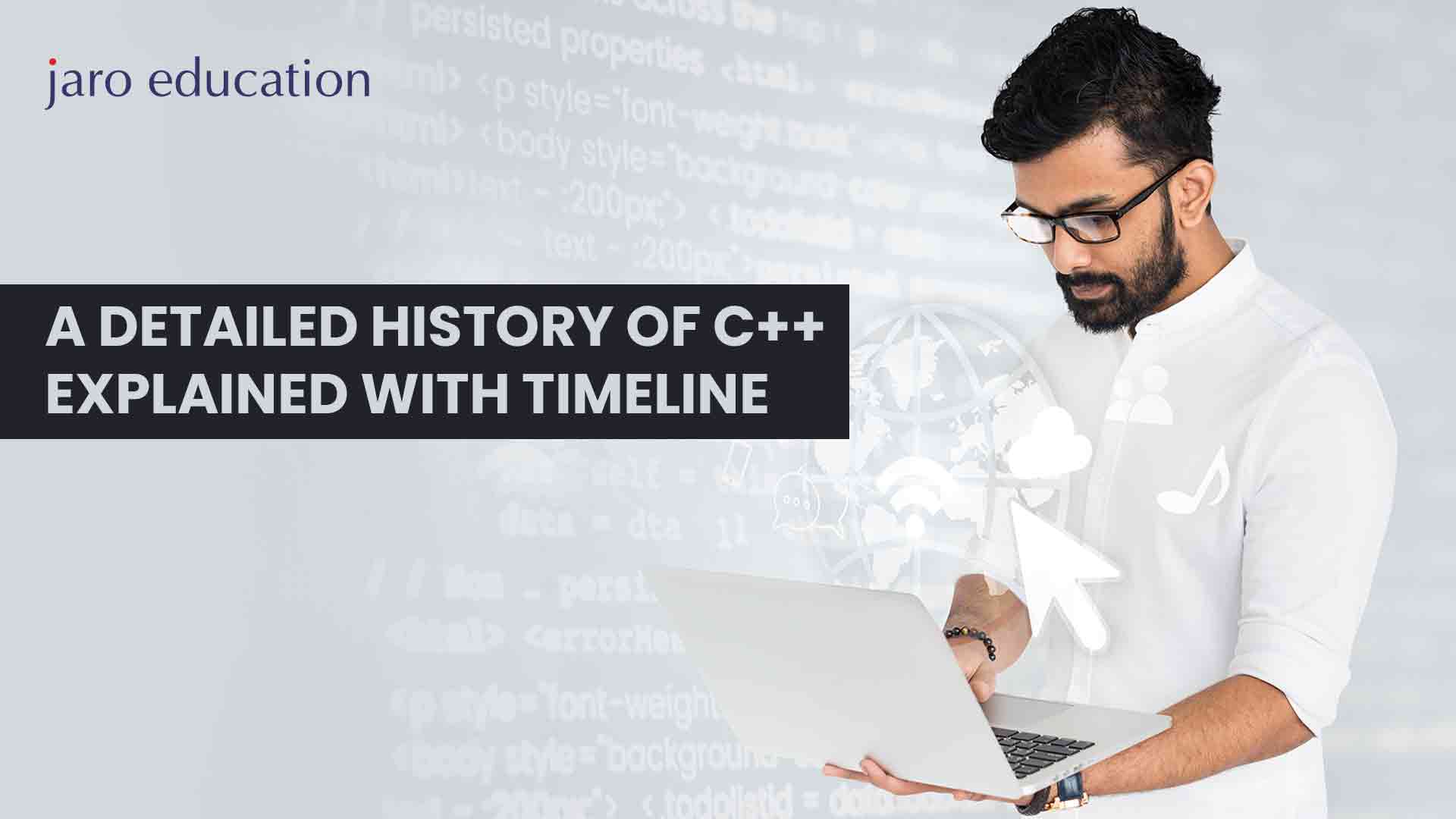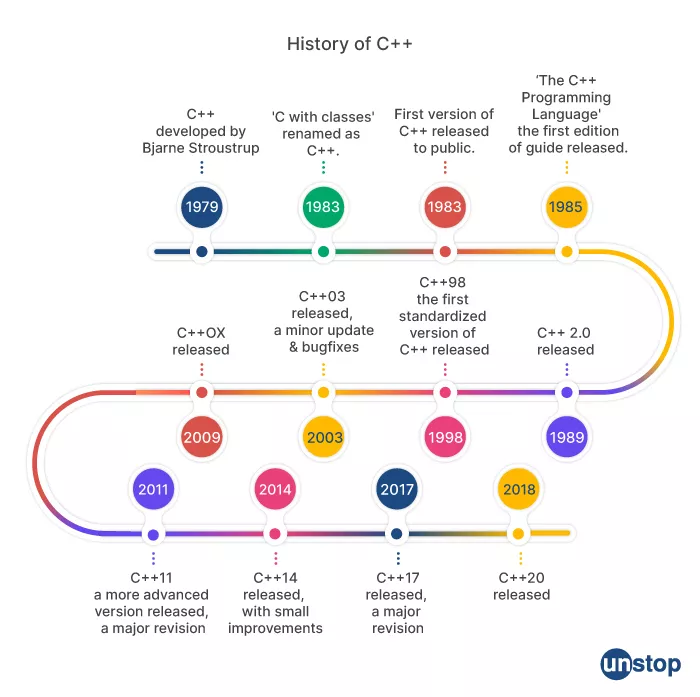A Detailed History Of C++ Explained With Timeline
Table of Contents

- jaro education
- 6, July 2024
- 6:00 pm
C++, with its robust syntax and performance-centric approach, stands as a pivotal cornerstone in the world of modern programming. Engineered for software where efficiency and flexibility are critical, it has deeply influenced the development of operating systems, game engines, and even other programming languages. Originating from the need to enhance the C programming language, C++ introduced object-oriented features that would later define and dominate software design paradigms.
The journey of C++ began in the early 1980s when Bjarne Stroustrup, a computer scientist, sought to amalgamate the programming discipline of C with the benefits of object-oriented programming (OOP). His goal was straightforward yet ambitious: to create a language that could manage complex systems with higher-level abstractions, yet without sacrificing the close-to-the-metal performance that C provided. This quest led to the history of C++—the precursor to what we now simply know as C++. Over the decades, C++ evolved through multiple iterations and standardizations, each enhancing its functionality, efficiency, and ease of use.
As we delve deeper into the timeline and history of C++, we will explore how each major update introduced new features that responded to the growing needs of developers and the software industry. From managing memory manually to harnessing the power of modern processors with advanced features like concurrency and lambdas, C++ has shown an impressive ability to grow and adapt, ensuring its place at the heart of software development for applications where performance is paramount.

cloudfront.net*
The History of c++| Late 1970s to Early 1980s: Setting the Stage
In the late 1970s and early 1980s, the computing environment was undergoing significant changes. The era was marked by a rapid evolution from bulky, centralized mainframes to more accessible minicomputers. Programming was predominantly done in languages like FORTRAN for scientific computing and COBOL for business applications, with C gaining popularity for systems programming due to its efficiency and control over system resources. However, as software systems grew more complex, the limitations of these languages, particularly in terms of code organization and maintenance, became apparent. The history of C++ is closely tied to these developments
Bjarne Stroustrup’s Motivation
Bjarne Stroustrup, working at AT&T Bell Labs, recognized the need for a language that could handle complex systems with more ease and flexibility. Inspired by his work on the UNIX operating system, which was written in C, Stroustrup sought to enhance the language to support classes, stronger type checking, and automatic resource management—features that were prominent in higher-level languages like Simula (considered the first object-oriented language). His goal was not to replace C but to extend it in a way that programmers could manage large software projects with better tools at their disposal. This motivation was a significant part of the history of C++.
Introduction of “C with Classes”
In 1979, Stroustrup began developing “C with Classes,” the precursor to C++. This new language included all the functionality of C along with additional features such as classes, basic inheritance, inlining, default function arguments, and strong type checking. The idea was to introduce object-oriented programming (OOP) features while maintaining the speed and efficiency for which C was known. This period marks a crucial phase in the history of C++.
“C with Classes” was initially used internally at Bell Labs for telecommunication systems, which benefited immensely from the added features. The language allowed for more modular code, which could be more easily reused and maintained. It also introduced the concept of constructors and destructors for automatic initialization and cleanup, significantly reducing bugs and memory leaks. These advancements are key milestones in the history of C++.
The development of “C with Classes” was a critical step towards the modern C++. It addressed the growing need for a sophisticated tool to manage rising software complexity without abandoning the principles that made C efficient and popular. This foundation set the stage for the further evolution of the language, leading to the creation of C++ as it is known today, a language that seamlessly combines the efficiency of C with the flexible features of object-oriented programming. The history of C++ is marked by these innovative steps.
Understanding the history of C++ provides valuable insights into why it was developed and how it has shaped modern programming. By looking back at its origins, we can appreciate the vision and innovation that drove its creation and its lasting impact on the software development industry. The history of C++ continues to influence the way we approach programming and software design today.
Standardization and Early Growth of C++ | Mid-1980s to 1990: Transition and Expansion
The official renaming of “C with Classes” to C++ occurred in 1983, symbolizing the language’s evolution beyond a mere extension of C. The name C++ was a playful technical pun proposed by Rick Mascitti, suggesting an increment or improvement upon the C language, echoing the C increment operator “++”. This name change coincided with significant enhancements to the language, aligning it more closely with the object-oriented paradigm which was gaining prominence at the time.
Key Features Introduced
Several key features were introduced during this period, shaping the core functionality and appeal of C++:
- Virtual Functions: This feature enabled polymorphism, a core concept in object-oriented programming, allowing for more dynamic and flexible method implementations. The inclusion of virtual functions is a notable event in the history of C++.
- Operator Overloading: This allowed custom implementation of operations for user-defined types, making the language more expressive and allowing types to behave like built-in types, which enhanced the readability and maintainability of the code. Operator overloading played a significant role in the history of C++ by making it more versatile.
- Multiple Inheritance: Extending the capability to inherit characteristics and functionalities from more than one parent class, providing a powerful, albeit complex, tool for developers. Multiple inheritance is another important aspect of the history of C++ that contributed to its power and flexibility.
The Release of the C++ Standard | 1990 to 1998: Overcoming Challenges and Establishing a Benchmark
The journey to the first official C++ standard was both challenging and transformative, significantly shaping the future trajectory of the language. This period was crucial for consolidating various extensions and compiler-specific features into a cohesive standardized language.
Challenges in Standardizing C++
Standardizing C++ was a formidable task due to several factors:
- Diverse Implementations: By the early 1990s, multiple compilers existed, each with its own set of extensions and deviations from Bjarne Stroustrup’s original implementation. Harmonizing these into a single standard that could satisfy all segments of the community was a complex endeavor.
- Balancing Innovation with Legacy: C++ needed to remain backward compatible with C to maintain its user base and practical utility. Simultaneously, it aimed to integrate cutting-edge features from more modern programming paradigms. Striking this balance without compromising on performance and usability posed a significant challenge.
- Complex Features: Features like templates, exceptions, and multiple inheritance brought powerful capabilities to C++ but were difficult to standardize due to their complexity and the variations in their implementations across different platforms.
Overview of ISO/IEC 14882:1998
The culmination of these standardization efforts was the ISO/IEC 14882:1998 standard, released in 1998. This standard not only unified the syntax and semantics of C++ but also aimed to ensure compatibility across different platforms and compilers, fostering broader adoption and more reliable performance.
Significant Features and Enhancements in This Release
The 1998 standard introduced several key features and enhancements that were instrumental in shaping modern C++:
- Templates: The standard greatly expanded the capabilities of templates, including the introduction of template instantiation and specialization, enabling more powerful and flexible generic programming techniques.
- Standard Template Library (STL): The inclusion of the STL was a major milestone. It provided a rich set of algorithms and container templates, allowing for more efficient data manipulation and establishing a foundation for high-performance, reusable code.
- Exception Handling: Standardized exception handling provided a structured way to handle errors and special conditions in programs, improving the robustness and maintainability of large-scale software projects.
- Namespaces: To better manage the growing complexity and to avoid name collisions in larger codebases, namespaces were introduced as a means of encapsulating groups of related functions, classes, and variables.
These features significantly enhanced C++’s functionality and robustness as a programming language. They addressed both the needs of complex software engineering projects and the desires of developers for a more manageable and powerful language. The release of the 1998 standard marked a pivotal moment in the history of C++, solidifying its role as a staple language for systems programming and large-scale software development, with a well-defined path for future evolution and improvements.
Modernization and New Features: 1998 to 2011
The period from 1998 to 2011 marked a crucial phase in the evolution of C++, focusing on refining the language and setting the groundwork for significant modernizations that would redefine its capabilities and extend its utility in complex software development.
Introduction of the Standard Template Library (STL)
The incorporation of the Standard Template Library (STL) into the C++ standard in 1998 was a transformative moment for the language. The STL provided a powerful set of generic classes and functions, revolutionizing the way programmers approached common tasks in C++. This library included:
- Containers: Various classes such as vectors, lists, and maps that could be used to store data.
- Algorithms: A suite of methods to perform operations such as sorting, searching, and transforming data.
- Iterators: Objects that enable programmers to traverse through the elements of a container.
The STL not only enhanced the efficiency and readability of code but also significantly decreased development time by offering well-tested components ready for implementation in various applications.
C++03 Minor Technical Corrections and Amendments
In 2003, the C++ standards committee released a minor update, known as C++03, which focused on clarifying the existing language features introduced in the 1998 standard. This update was crucial for ensuring greater consistency and stability across different compiler implementations and did not introduce new features. Instead, C++03 addressed:
- Ambiguity Resolution: Clearing up ambiguities in the language specification to ensure that the C++ code was more portable and behaved consistently across various platforms and compilers.
- Bug Fixes: Correcting issues that had been identified by the community, which helped stabilize the newer features introduced with C++98.
- Standard Library Fixes: Improving the implementation of the STL, enhancing its compatibility and functionality, reflecting the community’s response to the practical use cases of the standard library.
The Lead-up to C++11
The period leading up to the release of C++11 was characterized by intense deliberation and development, as the community and the standards committee aimed to address the evolving needs of modern software development. The objectives were clear:
- Enhance Language Usability: By introducing features like auto type declarations and range-based loops, the aim was to make C++ easier to learn and use, reducing common coding errors and improving code clarity.
- Support for Concurrency: Given the rising importance of multi-threading in software development, C++11 focused on providing robust support for concurrency to harness the power of multi-core processing.
- Optimize Performance: Features such as move semantics and perfect forwarding targeted at optimizing the performance of C++ applications, particularly those requiring high efficiency and speed.
This period was crucial in transitioning C++ from a language that was already powerful and widely used into one that was also modern, easier to use, and more aligned with the needs of contemporary developers. The groundwork laid during this time ensured that the subsequent release of C++11 would be well-received and would mark a significant step forward in the language’s evolution.
C++ and Its Influence on Other Programming Languages
C++ has been a foundational force in the evolution of programming languages, contributing its robust features to the programming paradigm and shaping the development of many modern languages. Its influence extends from its rich object-oriented features to its efficient memory management techniques, setting a benchmark for subsequent languages aiming for both performance and versatility.
Influencing Language Design and Concepts
The design of C++, characterized by its support for both low-level memory manipulation and high-level object-oriented features, has directly influenced the architecture and capabilities of many newer languages:
- Object-Oriented Programming (OOP)
- Languages Influenced: Java, C#, and Python.
- Influence Details: C++ was one of the first languages to implement object-oriented concepts such as classes, inheritance, polymorphism, and encapsulation comprehensively. These features have been integral to Java and C#, which mimic C++’s approach to class definition and inheritance. Python also adopted object-oriented paradigms that allow for more dynamic type usage.
- Generic Programming
- Languages Influenced: Java, C#, Swift.
- Influence Details: C++’s introduction of templates revolutionized the concept of generic programming, allowing for the creation of functions and classes with placeholder types that are specified only during instantiation. This has inspired Java’s generics, C#’s generic types, and Swift’s generics, which all facilitate type-safe data structures and algorithms.
- Performance Optimization
- Languages Influenced: Rust, Swift.
- Influence Details: C++ has been pivotal in demonstrating how language design can impact performance, particularly through its features like manual memory management and low-level system access. Rust takes this further by enforcing memory safety without garbage collection, and Swift adopts automatic reference counting (ARC) to manage memory more efficiently, both drawing from C++’s emphasis on performance.
Examples of Concepts Borrowed from C++
Several modern programming languages have borrowed key concepts from C++ to enhance their functionality and performance:
- Resource Management: Rust’s ownership model and Swift’s ARC system both derive from C++’s principle of Resource Acquisition Is Initialization (RAII), which manages the lifecycle of resources like memory and network connections.
- Error Handling: Structured exception handling in C++ paved the way for more robust error management systems in languages like Java and C#. These languages refined C++’s exception model to offer more features like finally blocks and chained exceptions.
- Concurrency and Multithreading: The multithreading capabilities of C++ influenced Go’s goroutines and Rust’s thread-spawning techniques, which provide more safety and ease of use for managing concurrent operations.
C++’s comprehensive feature set and its adaptability have made it a template for other languages, which have adopted and adapted its structures to suit newer paradigms and technologies. As these languages evolve, the foundational principles of C++ continue to play a significant role in guiding their development, ensuring that efficiency and flexibility remain at the forefront of software development.
Conclusion
C++ has charted a remarkable journey since its origins in the early 1980s, evolving from an enhancement of the C language to a powerful tool in its own right that seamlessly integrates procedural, object-oriented, and generic programming. The history of C++ is marked by key developments, such as the formal adoption of the Standard Template Library and the transition through several standardized versions, each introducing essential features that have significantly shaped its functionality. With a solid foundation laid down by the introduction of innovative concepts such as templates and exception handling, C++ has not only influenced contemporary programming practices but has also paved the way for the development of newer languages, imparting its robust, efficiency-driven ethos.
In a world that is constantly evolving with technology, having a strong foundation in programming and management skills is crucial. If you’re looking to advance your career and gain a comprehensive understanding of business administration while developing your technical skills, consider enrolling in the Online BBA Program at Manipal University Jaipur. This program offers a flexible and well-rounded curriculum designed to equip you with the knowledge and skills needed to excel in today’s dynamic job market.
The language continues to be indispensable in areas demanding high performance and system-level interaction, such as software development for operating systems and complex simulations. The dedication to maintaining its relevance through continuous updates and the integration of modern programming features ensures that C++ remains a critical tool in the developer’s toolkit. Its enduring presence in the programming community and persistent evolution reflect its adaptability and lasting importance in tackling modern software challenges.











